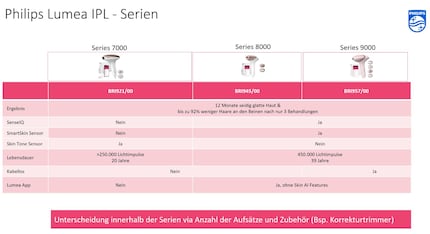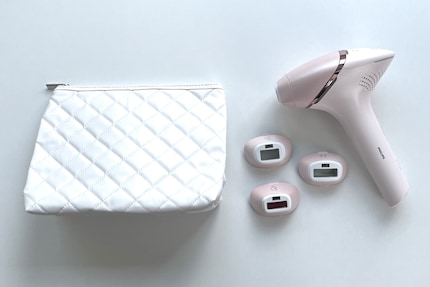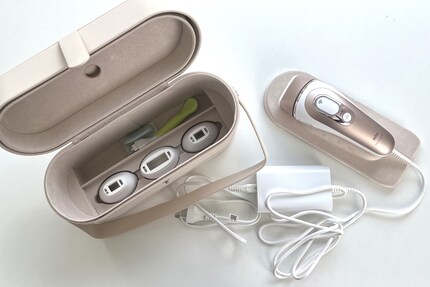
Guide
How to cut your child’s hair: simple tips from a pro
by Katja Fischer

I tested IPL devices for home use for two months. Does permanent hair removal work, and what are the advantages and disadvantages of the Philips and Braun devices? Time to find out.
For my product test, manufacturers Philips and Braun provided me with test devices, which I returned after the test
All test devices by both manufacturers are easy to use. You can either watch a video tutorial, let the app guide you through the steps or go for an old-school look at the manual. To put the devices through the acid test, I rely on the provided manual. Although it’s not overly detailed, I find all the information I need and can get started quickly.
The short video tutorials explain how to use the devices in no time:
To begin with, you need to define your skin type and the colour of your hair. You then adjust the intensity of the light pulses accordingly. Next, you carry out a tolerance test by applying a pulse of light and then waiting 15 minutes to see how your skin reacts. I feel a bit of heat, but no pain. After 15 minutes, my skin still looks the same. Tolerance test passed! Time to get started.
The devices offer two options. You can either move along your skin pulse by pulse, or you press the button for continuous light pulse and move the device over your skin at an even pace. In the latter mode, light automatically flashes at regular intervals. This is recommended for larger parts of the body, such as the legs.
As mentioned above, a single IPL treatment isn’t enough. As the hairs only react to the light impulse during a growth phase, it takes several goes until you catch the majority of your hair at the right time. The Lumea series comes with the advantage that it only needs to be used every other two weeks. The i-expert, on the other hand, needs to be used once a week.
The treatment plan for the Lumea devices is as follows: during the initial phase, you treat your body areas four times every two weeks. The manufacturer recommends follow-up treatments every four weeks. After eight of these after-treatments, Philips promises that you’ll have smooth skin for months. In other words, we’re talking ten months until your skin is more or less hair-free in the long term.
Weekly use is recommended with the i-expert. At least in the initial phase that lasts four to twelve weeks. If no more hairs are visible, there’s no need to apply the treatment every week for the full twelve weeks. After the initial phase has been completed, Braun recommends a follow-up treatment every one to two months to maintain the result.
I make sure to avoid my tattoo and larger moles. When I accidentally flash a tiny part of the tattoo, I understand why it’s a good idea to leave out. It really hurts. I’ll be all the more careful not to go there during the next treatments.
After my holidays, I can resume the treatment. I’ve since become quite a pro at this, so it takes me less time to treat all the parts of my body I want hairless.
Science editor and biologist. I love animals and am fascinated by plants, their abilities and everything you can do with them. That's why my favourite place is always the outdoors - somewhere in nature, preferably in my wild garden.
Practical solutions for everyday problems with technology, household hacks and much more.
Show allSummer’s just around the corner, and with it the swimming season and time for bare legs. It’s the time when I could really do without little hairs, stubble and razor bumps on my legs and other parts of my body. IPL devices claim they have the solution. In full, it’s Intense Pulsed Light, which puts the hair roots into a kind of dormant state, thereby putting an end to hair growth for a certain period of time. At least that’s how the theory goes. How well does this work in practice, and what are the advantages and disadvantages of different devices? Here’s what I found out during a product comparison.

My hopes of getting rid of annoying hairs forever in no time with little effort were dampened when I started to read up on IPL technology. Looks like I’ll need patience until I see any visible results. Not least because you need to repeat the IPL treatment several times. But the long-term time I’ll be saving compared to the alternatives (shaving and epilating) sounds promising to me.
I started the treatment in mid-February in the hope of being able to get away without shaving or epilating by the start of the swimming season. The instructions for the three Lumea devices of the different series are all the same, so I can test all devices without additional reading. At first, I use all three series, but from the third treatment onwards I stick with my favourite, the 9000 series. It’s the only wireless one, so simple and straightforward. It also features four different attachments. In addition to the standard one, there’s a separate attachment for the face, armpits and bikini line.
I’m surprised at how quick and easy the first run is. The skin tests show I can use the highest intensity on all parts of my body. Treating my bikini line, face and armpits with the 9000 series works smoothly, so I’m done in just a few minutes. I use the 8000 series for the left lower leg and am done after seven minutes. That’s faster than the time specified by Philips (hopefully I was thorough enough). With this model, I can feel a bit of heat with every flash of light on the highest setting, but it’s not painful. I use the 7000 series on my left lower leg. This one has fewer buttons and no skin test. The intervals between the light pulses also seem longer to me with this model, and it takes me almost twice as long overall.

Next, I use the i-expert for my thighs. I like the fact that it’s less bulky than the Lumea devices and easy to hold. This time, I don’t set each light impulse individually, but glide over my leg with the button pressed. This makes the flashes come quickly one after the other, and the whole affair is over very quickly. With the individual flashes of light, I often found it tricky to know which areas I’d already passed over. The flowing movement I make with this model makes it easier for me to keep track of which bits I haven’t done yet. Philips devices also have this function.

Fast forward one week and the i-expert’s back in use. The Lumea devices only come out of the box after two weeks. After an IPL treatment, your skin shouldn’t be exposed to intense light for two weeks. In other words, keep those areas out of the sun if they’re unprotected. However, I’m travelling south six weeks after I start the treatment, so I take a break four weeks after starting IPL, i.e. after the fifth (i-expert) and third (Lumea) treatment. At this point, I’m already noticing a difference. Overall, there are definitely fewer hairs growing in the treated areas. I’d say about 30 per cent less. I don’t see any difference that can be attributed to a particular device.
Both the Philips devices (with the exception of the 7000 series) and the Braun device offer apps to make things easier. However, if you don’t want to use an app, you’ll be fine without it. Many things are self-explanatory, and if information is missing, the operating instructions will fill in the gaps. I deliberately started without the help of the apps and it was no problem. But if you want step-by-step instructions and other additional features, you can download the apps using the enclosed QR codes and start from there.
Two months after I ventured into IPL treatment, I can draw a positive conclusion for the time being. Keep in mind that it’s not a final conclusion, because I’ll be continuing with the treatments for a while to get the results I really want.

Siemens EQ700 integral TQ717D03